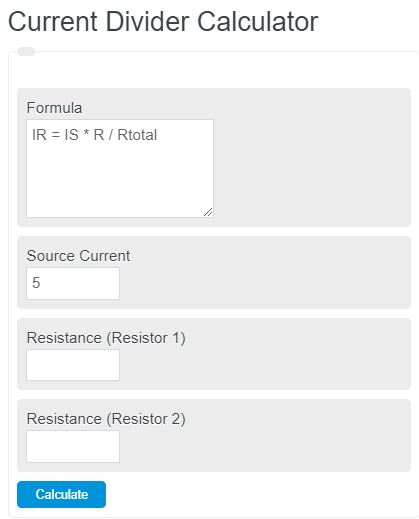Enter the current of the source and the resistance of the resistors into the calculator. The calculator will display the current through each resistor entered.
- Voltage Divider Calculator
- RC Circuit Calculator
- RLC Circuit Calculator
- Current Density Calculator
- Fault Current Calculator
Current Divider Formula
The following formula is used to calculate the current going through an individual resistor of a series of resistors.
IR = IS * R / Rtotal
- Where IR is the current through the current resistor (amps)
- IS is the source current (amps)
- Rtotal is the total of all the resistors in the series (ohms)
- R is the resistance of the individual resistor (ohms)
Current Divider Definition
A current divider is a fundamental concept in electrical engineering that describes current distribution in a parallel circuit.
When a current flows through a network of resistors connected in parallel, the total current entering the network divides among the individual branches according to their respective resistance values.
Within a parallel circuit, each resistor provides a separate path for the current to flow. The current divider principle states that the branch currents are inversely proportional to the resistance values of the branches.
In other words, the higher the resistance, the smaller the current flowing through that branch.
One key importance of the current divider is its ability to control and regulate the current flow within a parallel circuit. By carefully choosing the resistance values of the branches, engineers can manipulate the current distribution and ensure that specific components receive the desired amount of current.
Current dividers are vital in designing and analyzing circuitry. By understanding how current divides in a parallel circuit, engineers can accurately calculate and predict the behavior of the components within the network.
Current Divider Example
How to calculate a current divider
- First, measure the source current
Measure the source current value in Ohms.
- Next, measure the resistance of the individual component
This will be the resistance of the component only, which could be anything from a resistor to a capacitor.
- Determine the total resistance
Add of the total resistance of all of the components in the series
- Calculate the the current
Calculate the current in the individual resistor using the information from steps 1-3 and the equation presented above.
FAQ
How does the resistance of a resistor affect the current flow in a parallel circuit?
The resistance of a resistor inversely affects the current flow in a parallel circuit; higher resistance results in lower current flow through that branch, and vice versa.
Why is it important to calculate the current through individual resistors in a circuit?
Calculating the current through individual resistors is crucial for designing circuits to ensure that each component receives the appropriate amount of current to function correctly without being damaged.
Can the current divider principle be applied to circuits with components other than resistors?
Yes, the current divider principle can apply to circuits with various components, as long as they have equivalent resistances that can be calculated, such as inductors and capacitors in AC circuits.
What are some practical applications of current dividers in electrical engineering?
Current dividers are used in various applications, including sensor circuits, power distribution, signal processing, and controlling the current flow to specific parts of a circuit to protect sensitive components or to ensure optimal operation.

